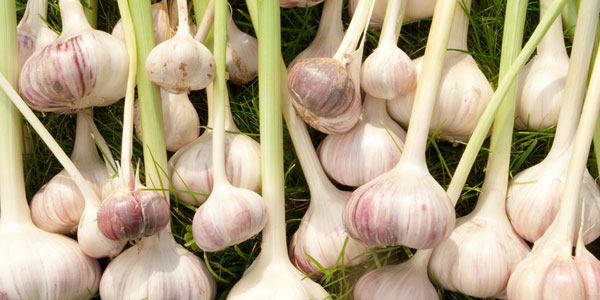
Why not? Garlic is good in so many dishes (there’s even garlic ice cream at the Gilroy festival) and is so good for you – a great way to boost your heart health – that growing it in the back yard or a pot may not be a bad idea. In fact, it’s a good idea because what you will get can be much better than the commercial variety.
Table of Contents:
Growing Garlic
One thing you would never be able to tell by looking at the garlic in supermarket bins is that there are many different varieties, each with their own preferences in growing conditions – the mixture of soil, sun, and moisture. (The type found in supermarkets is usually Artichoke garlic.)
The good news, according to Gourmet Garlic Gardens, is that garlic is pretty easy to grow. But, that as the site cautions, getting great garlic requires some work.
Garlic comes in two subspecies. The soft-necked garlics were developed over centuries from the original hard-neck garlics through a process of selection; they include Creole, Asiatic, Turban, Artichoke, and Silverskin. Hardnecks come in five varietals: Porcelain, Purple Stripe, Marbled Purple Stripe, Glazed Purple Stripe, and Rocambole. Hundreds – perhaps 600 – of sub-varieties of these two varieties are grown throughout the world. The sub-varieties differ in flavor, pungency, sweetness, storage characteristics, growing preferences, and production. But, because most garlic originated in the Caucasus, a large number of them have become available in the United States in only the past few years.
It was only in 1989 that the Soviet Union allowed the U.S. Department of Agriculture to collect garlic sub-varieties over there and bring them into the USA. Growing the garlic was contracted out, so that new varieties are now available, though expensive. As they become more plentiful, their price will go down.
Organic Garlic
If you are going to grow garlic, do it organically. Pesticides are poison. Chemical fertilizers are not good for you, and they don’t do much for garlic, either, which prefers manure and compost, with some trace minerals added to the soil. Here are the steps to follow:
- Choose the sub-variety you’re going to grow, checking that it’s suitable for growing in your area. Artichoke garlic will grow just about anywhere, but do you really want the same thing you can buy in the supermarket?
- Plant in autumn close to the autumnal equinox in deep pots or raised beds with good drainage. The bulb should be above the water level and the roots below. Use higher beds in areas that get a lot of rain and very cold winters, and mulch heavily. In more arid areas, lower the beds and keep the bulbs shallow.
- Break a bulb into cloves and soak each overnight in a water solution containing 2 tbs. of bicarbonate of soda and liquid seaweed to destroy any fungi spores. Discard the clove covers that will come off. Soak the cloves in rubbing alcohol for three or four minutes to kill any eggs of pests and plant immediately.
- Put the cloves in holes about three inches deep and about the distance of two bulb-widths apart. Cover with a couple of inches of mulch. Drip irrigation is best for garden planting; keep cloves planted in pots moist but not too wet.
- When the leaves start turning brown and wilting, it’s time to harvest the garlic – usually sometime in May or June. The longer you leave the garlic in the ground, the more potent and stronger the flavor becomes. Be careful not to damage the garlic while harvesting; loosen the soil with a fork before pulling the garlic loose.
- Let the garlic sit for about three weeks in mild temperatures, away from sunlight, before trimming off the tops. Store it out of the sunlight in open containers, not jars or plastic bags. Garlic stores best between 55- and 65-degrees and between 40% and 60% humidity.